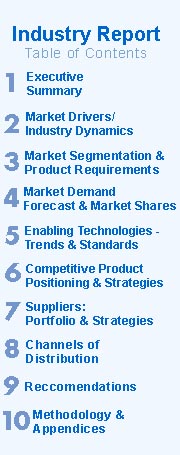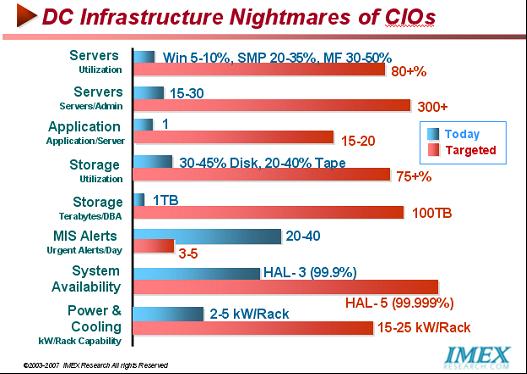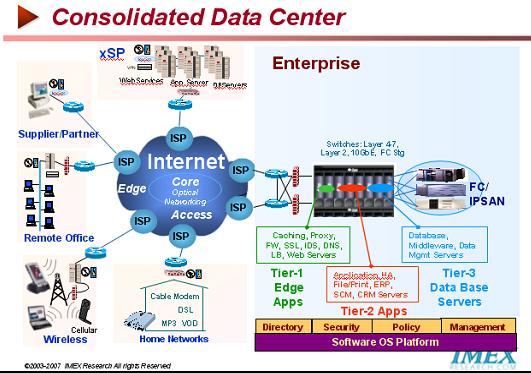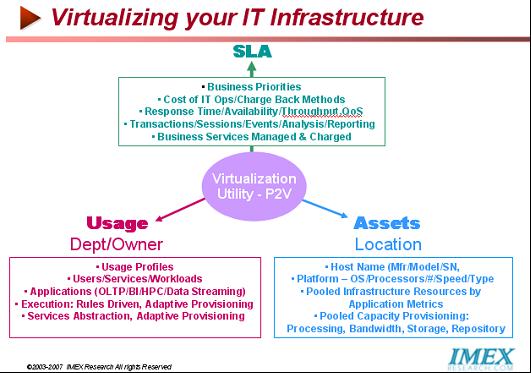The Demand for NexGen Data Centers Click on Executive Summary and Table of Contents for additional information. |
|||
| Genesis of Next Gen Data Centers |
|
||
| With IT evolving into a key strategic asset for business success, CIOs constantly find themselves at crossroads in deciding if and when to venture into emerging technologies that are starting to shape the next generation data centers. Their challenge lies in traversing a maze of competing technologies and tools to choose from while avoiding hype from vendors in the creation of an adaptable, scalable and highly available infrastructure that not only will respond, on-the-fly, to changing critical business needs but will get implemented without disrupting existing IT processes. The IMEX Report on NGDC 2008 provides guidance on various technologies: what they are, their hierarchical significance and strategic impact on the operation of datacenters in support of IT to run the businesses. In the internet driven era of online eCommerce transactions, web 2.0 collaboration technologies and business intelligence from enterprise and web searches, all are giving rise to a whole new set of possibilities of achieving business efficiencies hitherto heard of or feasible.
|
|||
| IT managers often deployed servers, storage, and network equipment in dedicated configurations, application by application in an adhoc fashion. The resulting data center ended up consisting of isolated application environments with low resource utilization, higher cost, complex management and an inordinate amount of power consumption. |
|
||
|
A New Data Center Model Needed The nextgen Data Center Architecture is based on the principle that by making the right investment in the infrastructure, CIOs can dramatically increase productivity and efficiency while improving business resilience, reducing costs, and aligning with critical mission priorities. It provides a system-level framework that addresses data center demands for consolidation and business continuance in the short term while targeting Infrastructure Services and Application Services inplementation to enable emerging Service-Oriented Architectures (SOAs) and On-demand, Software as a Service (SaaS) Cloud Computing technologies. The DC Architecture framework described in the report, outlines how enterprises can evolve to an Intelligent Information Network that optimizes applications, business processes, and resources. IMEX Research has established a series of metrics that the next generation data center architecture approach must provide and provides detailed guidance for IT infrastructure vendors IT purchase decision makers on how to optimally deploy compute, storage, intelligent information networks and software technologies that best support their mission needs through optimizing IT resources and business processes. IT Trends driving NexGen Data Center
SIVA for a scalable, dynamic On-Demand NGDC The architectures must leverage the hardware standardization, integration and consolidation, virtualization, provisioning and automation of resources (servers, storage, networking and software) to deliver application services. Further this architecture would need to optimize for always on availability, business processes efficiencies to provide derived business intelligence, security, collaboration and regulatory compliance while embracing and leveraging emerging technologies such as Blade Servers, Virtualization, IP Connectivity, Resiliency and rapid disaster recovery. 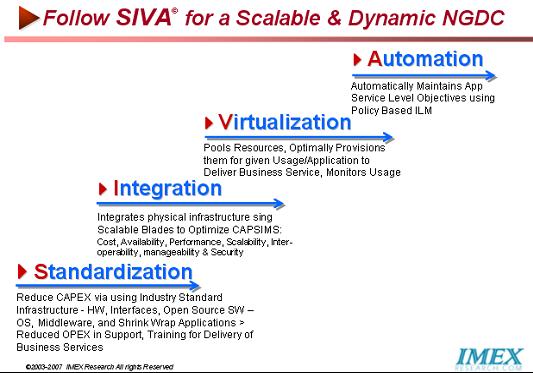
Consolidating your IT Infrastructure using Virtualization Virtualization is a major disruptive technology of great transformational potential in delivering compelling benefits of significantly improving TCO and ROI in IT organizations. (1) Creating a framework of goals and metrics in choosing and implementing virtualization and blades servers resources for NGDC (2) Creating a TCO/ROI model for business justification (3) Criterion for Emulation vs. Host based Virtualization, Host hardware platform, Storage, Network and Power/Cooling Considerations (4) Planning for software licensing issues (5) Selection of tools for P2V migration, performance and resource utilization monitoring and management (6) Cascades selection of applications/workloads to port to achieve optimal cost savings and data center efficiency Virtualization Implementation Strategies • Implement Virtualization in 3 phases. (1) Consolidate through Virtualization and Workload Management. (2) Pool and share resources to achieve HA/BC/DR, Workload Balancing and Automation and (3) Reduce number of systems footprints & OS instances since OSs lick costs and raise management administration costs)
. IMEX Industry Report - NextGen Data Center 2008 IMEX Research‘s Industry Report on NexGen DataCenter 2008 addresses the need to fully understand the directions of the IT industry vendors will take in formulating products to meet the need of the demands of CIOs and Datacenter operations.It enumerates a number of metrics for data center to achieve and provides detailed guidance for IT infrastructure vendors and IT decision makers (CIOs and operations managers) on how to optimally deploy compute, storage, intelligent information networks and software technologies that best support their mission needs through optimizing IT resources and business processes. Subjects analyzed • Datacenter technology trends: what are the technologies for the next-generation datacenter? Major chapter include: |
|||
| Click on the following for additional information or go to http://www.imexresearch.com IMEX Research, 1474 Camino Robles San Jose, CA 95120 (408) 268-0800 http://www.imexresearch.com |
|||

